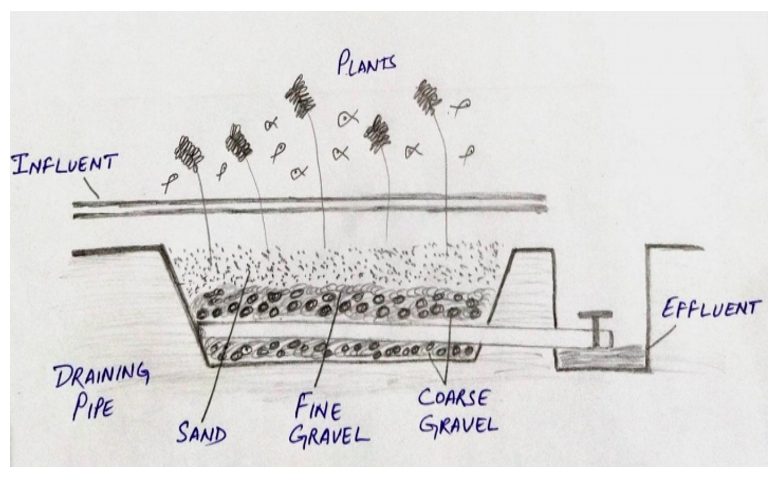This set of Marine Biotechnology Multiple Choice Questions & Answers (MCQs) focuses on “Aquaculture Management”.
1. Oyster farming can reduce nitrogen from coastal waters.
a) True
b) False
View Answer
Explanation: The shellfish aquaculture of oysters and mussels can aid in removal of tonnes of nitrogen per year from coastal bays and estuaries. According to a research published in aquaculture reports oyster farming can reduce 334 tonnes of nitrogen from Atlantic Canada’s nearshore ecosystems.
2. Bivalves can absorb nitrogen in __________________
a) shells
b) gills
c) pearl
d) sediments
View Answer
Explanation: Bivalves such as mussels and oysters can absorb nitrogen in their shells and deposit it in the sediments eventually after dying.
3. Enrichment of water by nutrient salts is called ______________________
a) Decontamination
b) Eutrophication
c) Bioremediation
d) Biostimulation
View Answer
Explanation: Enrichment of the coastal waters by nutrient salts is called eutrophication. It leads to harmful algal blooms, fish diseases and unsightly water bodies. Bioremediation is a way of mitigation of eutrophication.
4. Changing environmental conditions to enhance the growth of bio-degrading microbes is done by ____________________
a) biostimulation
b) bioaugmentation
c) intensive aquaculture
d) extensive aquaculture
View Answer
Explanation: There are two ways to accelerate the microbial breakdown of aquaculture waste, two strategies are adopted, bioaugmentation and biosimulation. Biostimulation is done by altering the environmental parameters.
5. Creation of adhesion sites is a way of biostimulating the residential microbes in aquaculture.
a) True
b) False
View Answer
Explanation: Creation of adhesion sites and introduction of artificial substrates to aid in biofilm formation is a way of stimulating the residential microbes in aquaculture. This leads to increase in the rate of breakdown of aquaculture waste.
6. Which type of biological filters encourages the growth of anaerobic bacteria?
a) Microbial mats
b) Activated sludge
c) Trickling filter
d) Denitrifying filters
View Answer
Explanation: Denitrifying filters encourage the growth of anaerobic bacteria to accelerate the conversion of nitrates to nitrogen gas. Anaerobic regions in the filter are created that encourage the growth of Thiobacillus denitrificans, Micrococcus denitrificans etc.
7. Which of the following is not involved in Integrated Multi-Trophic Aquaculture?
a) Aquaponics
b) Fed species
c) Inorganic extractive species
d) Organic extractive species
View Answer
Explanation: IMTA is a technique of polyculture that includes culturing of fed-species e.g. finfish and shrimps, inorganic extractive species such as microalgae and/ or organic extractive species such as shellfish.
8. _______________ improves water quality.
a) Finfish
b) Ornamental fish
c) Prawn
d) Wetlands
View Answer
Explanation: Wetlands improve the water quality by trapping suspended solids and degrading organic matter. The vegetation in constructed/natural wetlands removes organic nitrogen and carbon while the sediments trap phosphorus.
9. Which is associated with surface flow wetlands?
a) Microbial attachment
b) Bioaugmentation
c) Phytoremediation
d) Deforestation
View Answer
Explanation: There are two kinds of wetlands namely surface flow wetlands and subsurface-flow wetlands. In the former, gravel and sand are added to wetland base while in the latter plant vegetation is also incorporated to promote phytoremediation.
10. Identify the structure in the figure below.

a) Surface-flow wetland
b) Subsurface-flow wetland
c) shore protection structure
d) Artificial sand dune
View Answer
Explanation: The figure above is a prototype of surface-flow wetland. These wetlands incorporate gravel and sand for entrapment of suspended solids and act as substrates for microbial attachment. The vegetation absorbs nutrients and provides oxygen.
11. Which is not true in the context of bio-augmentation?
a) Introduction of bacterial strains
b) Introduction of enzymes
c) Changing pH of water
d) Balancing bacterial population
View Answer
Explanation: Changing the environmental conditions such as the pH of water is a way of bio-stimulating the native bacterial population. In bio-augmentation commercially prepared bacterial strains/enzymes are added.
12. Which is a common bio-augmenting agent used in aquaculture?
a) Bacillus
b) Saccharomyces cerevisiae
c) Thiobacillus
d) Nannochloropsis
View Answer
Explanation: The most widely used bio-augmenter in aquaculture is Bacillus species owing to their capability of secretion of wide variety of enzymes. The enzymes increase the rate of organic matter break-down.
13. To counter the limitation of enzymes, they are combined with ___________________
a) alginate
b) agar
c) fungus
d) bacteria
View Answer
Explanation: To eliminate the limitations of enzymes, a combination of enzymes and bacterial strains is used in bioremediation. After enzymes break-down the large sludge particles bacteria ferment the leftovers.
14. Gas sweetening process involves ____________________
a) clarification of methane
b) pressurizing gas
c) decreasing H2S content
d) increasing H2S content
View Answer
Explanation: Natural gas such as methane used for various purposes in households contains a small amount of hydrogen sulphide (H2S) – sour gas. The sour gas must be treated to bring the H2S to acceptable level of 10 ppmv – referred to as gas sweetening.
15. _________________ is better than aerobic desulfurization.
a) Anaerobic desulfurization
b) Alkali treatment
c) Bicarbonate treatment
d) Lyophilaztion
View Answer
Explanation: Anaerobic biological treatment is better than aerobic biological treatment of desulfurization. This is because during aerobic treatment leads to release of foul smelling gas.
Sanfoundry Global Education & Learning Series – Marine Biotechnology.
To practice all areas of Marine Biotechnology, here is complete set of 1000+ Multiple Choice Questions and Answers.
If you find a mistake in question / option / answer, kindly take a screenshot and email to [email protected]
